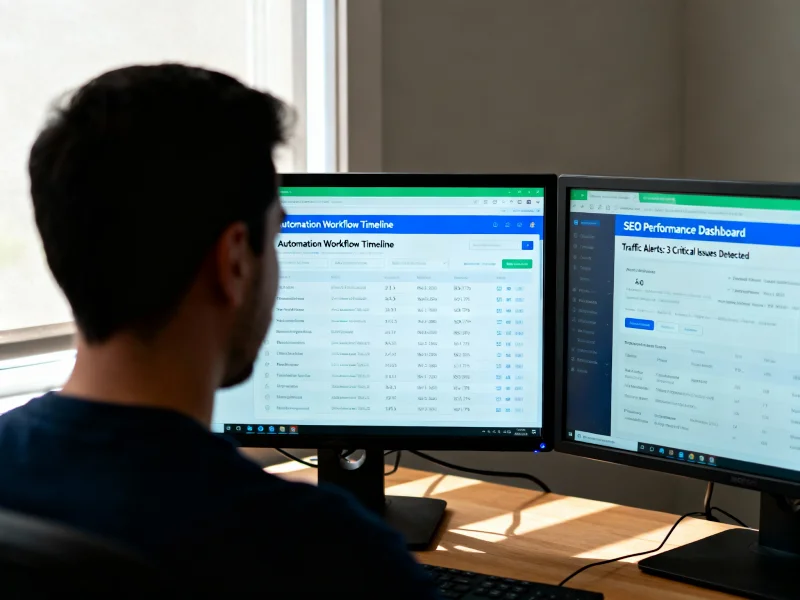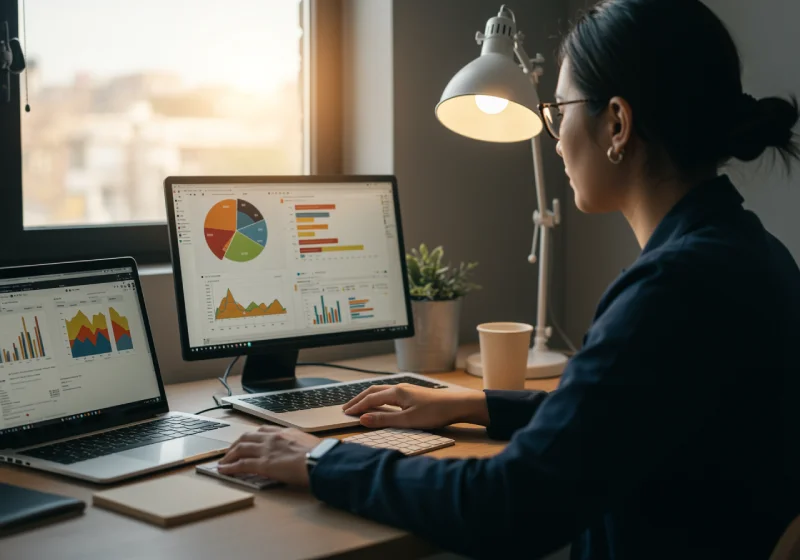Importance of Internal Linking for On-Page SEO
Internal linking serves as the backbone of a well-structured website, connecting pages in a way that enhances navigation and improves search engine visibility. Search engines use internal links to discover and index content, ensuring that important pages receive the attention they deserve. When implemented strategically, internal links guide users toward valuable information, keeping them engaged and reducing bounce rates. A well-planned internal linking strategy strengthens a website’s authority and provides a clear content hierarchy that benefits both users and search engines.
Learn the role of internal linking in on-page SEO and how it improves search rankings, user experience, and content discoverability. Discover how internal links distribute link equity, optimize site architecture, and enhance navigation. We will also cover best practices, common mistakes to avoid, and how expert SEO services can refine your internal linking strategy. By the end, you will understand how internal linking plays a critical role in SEO success and how professionals can help you implement it effectively.
How Internal Linking Supports SEO Strategy
Internal linking directly impacts how search engines assess and rank webpages. By connecting related content, internal links allow link equity (PageRank) to flow across a website, strengthening its authority. Pages with stronger internal linking structures often perform better in search results because they signal relevance and importance. Without this connectivity, valuable pages may struggle to gain visibility, making it harder for search engines to prioritize them. A strategic internal linking approach ensures that high-value pages receive the necessary authority to rank competitively.
Beyond rankings, internal links play a crucial role in site organization. They help search engines recognize the relationship between different topics, reinforcing a website's thematic relevance. When links are structured logically, crawlers can efficiently index pages, preventing content from becoming isolated. Websites with poor internal linking often experience crawl inefficiencies, leading to indexation issues and missed ranking opportunities. A strong linking framework sets the foundation for a well-optimized site, improving both technical SEO and user engagement.
A structured internal linking system strengthens content hierarchy, ensuring search engines recognize essential pages. By linking to deeper pages, businesses can highlight important content and encourage longer user sessions. This process also supports content discoverability, making it easier for visitors to find relevant information. To maximize these benefits, internal links should be optimized for both search engines and user experience. The way links guide users across a site determines how well they interact with content and whether they continue exploring.
Impact on User Experience and Navigation
A well-structured internal linking strategy improves user experience by making it easier for visitors to find relevant content. When users arrive at a webpage, they expect a logical flow that leads them to additional resources, related topics, or actionable insights. Intuitive linking encourages visitors to explore multiple pages, reducing bounce rates and increasing dwell time. Websites with clear navigation and well-placed links create a seamless browsing experience that keeps users engaged.
Internal links also serve as pathways that help users complete their journey on a website. Whether they are looking for answers, services, or purchasing options, internal links provide clear directions that align with their intent. Well-planned linking ensures that users do not reach dead ends, improving satisfaction and increasing the likelihood of conversions. By enhancing accessibility and guiding visitors through a structured content flow, businesses create a website that meets user expectations while supporting on-page optimization.
Search engines take user engagement signals into account when determining rankings. Pages with higher engagement and lower exit rates send positive signals that indicate valuable content. Strong internal linking encourages visitors to interact with multiple pages, boosting metrics that influence search visibility. Optimized navigation strengthens both user experience and search performance, ensuring that visitors and search engines recognize the value of a website.
A structured approach to internal linking benefits both users and search engines, but without a well-organized site architecture, these links may not function effectively. The way content is structured impacts the efficiency of internal linking and how well search engines understand the relationships between pages.
Optimizing Anchor Text for Internal Links
Anchor text is a key component of internal linking that directly impacts both user experience and search engine interpretation. Using clear, descriptive anchor text helps search engines understand the context of linked pages. Instead of vague phrases like “click here,” effective anchor text should incorporate relevant keywords naturally. This practice ensures that linked pages gain visibility for targeted search terms while providing users with clear expectations. Search engines analyze anchor text to determine the subject matter of the destination page.
Maintaining diversity in anchor text prevents over-optimization while ensuring a natural linking pattern. Repetitive use of the same anchor text can appear manipulative, leading to potential penalties. Instead, businesses should use variations that align with the page’s content and intent. For example, linking to a web design service page should include contextually relevant anchor text that naturally fits within the surrounding content. Strategic anchor text placement strengthens internal link signals and enhances SEO value.
Balancing keyword usage with readability is essential for an effective internal linking strategy. Overloading content with keyword-rich links can disrupt the user experience and reduce content clarity. By incorporating anchor text naturally, businesses maintain a smooth reading flow while optimizing for search engines. Well-optimized internal links contribute to a structured and informative browsing experience. These improvements tie directly into the broader concept of site architecture and its impact on SEO.
Site Architecture and Internal Linking Strategy
A well-designed site architecture strengthens internal linking by ensuring that pages follow a logical structure. Search engines prioritize websites with clear navigation, making it easier to understand the relationship between different pages. A strong site hierarchy improves indexing efficiency, preventing pages from being overlooked. When content follows a structured format, internal links reinforce topical relevance and improve discoverability. Here are some of the strategies.
- Establish a clear hierarchy – Organize content by placing high-value pages at the top and supporting pages below.
- Implement a pillar-cluster model – Connect core pages to related content, creating an interconnected system that strengthens SEO.
- Use contextual links strategically – Place links within content where they provide the most value to users.
- Avoid orphan pages – Ensure that all pages have inbound internal links to increase their visibility.
- Update links regularly – Conduct internal linking audits to identify broken or outdated links that need improvement.
Following a structured approach ensures that internal links serve their purpose effectively. Without a defined system, search engines may struggle to determine which pages hold the most value. A well-organized linking strategy helps distribute link equity, reinforcing important content while preventing dilution.
While businesses can implement basic internal linking practices, scaling this approach requires expertise. Managing a growing website’s internal links, maintaining structure, and ensuring efficiency can become challenging. This is where the expertise of a digital marketing agency becomes essential in optimizing internal linking for better results.
How a Digital Marketing Agency Can Help with Internal Linking Strategy
Managing an internal linking strategy requires careful planning, ongoing optimization, and technical expertise. Many businesses struggle to balance user experience with SEO best practices, leading to missed opportunities. Partnering with a digital marketing agency simplifies this process, ensuring that internal links are structured for maximum impact. Agencies conduct in-depth audits to identify weaknesses and develop tailored strategies that align with search engine guidelines.
Conducting a Comprehensive Internal Link Audit
A digital marketing agency begins by analyzing your existing internal link structure to identify gaps and inefficiencies. Audits uncover orphan pages, broken links, and missed opportunities that may be limiting search visibility. Agencies also assess the distribution of link equity to ensure important pages receive adequate authority. By evaluating anchor text usage, they ensure links provide clear context while avoiding over-optimization.
Optimizing Internal Links for Maximum SEO Impact
After identifying issues, agencies restructure internal links to enhance on-page SEO. They implement strategic linking methods, ensuring that pages connect in a way that benefits both search engines and users. Experts also optimize anchor text for clarity and keyword relevance while preventing unnatural patterns. A well-executed strategy ensures that internal links support rankings and improve content discoverability.
Enhancing Site Architecture and User Experience
Agencies refine site architecture to ensure smooth navigation and logical content flow. By implementing a hierarchical structure, they strengthen the website’s SEO foundation. This includes improving menu navigation, refining category structures, and aligning internal links with user intent. When executed correctly, internal linking improves website navigation, helping visitors find content effortlessly while reinforcing a structured SEO strategy.
Long-Term Monitoring and Strategic Adjustments
Internal linking requires ongoing maintenance to adapt to algorithm updates and content expansion. Agencies conduct regular audits to track performance, adjust strategies, and address broken or outdated links. They ensure that newly published content integrates with existing pages, keeping the website interconnected. Having continuous support from a top-rated online marketing agency provides businesses with the expertise needed to sustain SEO success.
Authority Solutions® Helps You Build a Powerful Internal Linking Strategy
Authority Solutions® specializes in designing internal linking strategies that strengthen search rankings and improve site navigation. Our expert team analyzes your website’s current structure, identifying key opportunities to enhance internal link placement. With a data-driven approach, we ensure that your site hierarchy and link distribution support both user experience and SEO goals. A well-structured internal linking system increases content visibility while reinforcing search engine trust.
We optimize internal links to distribute authority effectively across your website. By implementing strategic anchor text and reinforcing topic clusters, we create an interconnected system that boosts rankings. Our tailored approach aligns with search engine guidelines, ensuring compliance while maximizing results. A well-executed internal linking strategy reduces bounce rates and increases user engagement, contributing to higher conversion rates.
Our SEO services include internal link audits, content mapping, and structured optimizations. We work closely with businesses to develop a sustainable SEO framework that adapts to growth and algorithm changes. Internal linking plays a critical role in site optimization, and our team ensures that each link adds value.
Whether your business needs a comprehensive web design overhaul or technical SEO improvements, we provide customized solutions to enhance performance. Authority Solutions® delivers strategic SEO services that position your business for long-term success.
Conclusion
A strong internal linking strategy enhances search rankings, user experience, and site navigation. It helps search engines understand content relationships while guiding users to relevant pages. By distributing link equity efficiently, businesses improve discoverability and ensure important pages gain visibility. Internal links also contribute to user engagement, leading to longer session durations and higher conversion potential. When implemented effectively, internal linking strengthens overall on-page performance.
Authority Solutions® helps businesses build and maintain internal linking strategies that align with SEO best practices. Our experts analyze your website’s structure, implement targeted optimizations, and provide ongoing support to enhance performance. A well-optimized linking system reinforces site authority and improves search visibility.
Frequently Asked Questions
Why Are Internal Links Important in On-Page SEO?
Internal links play a vital role in connecting related pages within your website, helping both users and search engines navigate your content more efficiently. They establish a logical site structure, which improves user experience and helps search engines understand content hierarchy. Strategically placed internal links distribute authority across your pages, boost discoverability, and encourage deeper engagement. When used correctly, internal linking supports better indexing and strengthens your site's overall SEO performance.
How do internal links help search engines crawl my website?
Search engines rely on internal links to help them discover and index new content efficiently. When a search engine crawler visits a website, it follows internal links to understand the relationship between pages and assess their importance. Well-structured linking ensures that important pages receive attention while preventing orphaned content. The more accessible a page is through internal links, the better its chances of ranking.
What is the difference between internal and external links?
Internal links connect pages within the same website, while external links lead to content on other websites. Internal linking strengthens a site’s structure, improving navigation and SEO value. External links, on the other hand, can provide additional context and credibility when referencing authoritative sources. A balanced approach using both types of links enhances a website’s trustworthiness and SEO performance.
How many internal links should be on a page?
The number of links on a page depends on its length, purpose, and structure. There is no strict limit, but too many links can dilute their value and overwhelm users. A good rule is to add relevant internal links that naturally fit within the content while ensuring a smooth user experience. Prioritizing quality over quantity ensures effective link distribution.
Should I add internal links to every page on my site?
Yes, every page on your site should have at least one internal link to ensure it is accessible and properly indexed. Internal links create a logical structure that helps both users and search engines navigate the website. If a page lacks internal links, it risks becoming an orphan page, making it difficult for search engines to find. Linking strategically enhances a site’s overall SEO performance.
What are the different types of internal links?
There are several types of internal links, each serving a unique purpose. Navigational links appear in menus and sidebars, helping users move between key sections of a website. Contextual links are placed within content to connect related pages, enhancing relevance. Footer links provide quick access to essential pages, improving accessibility and user experience.
Can internal linking improve rankings for a specific page?
Yes, internal links are hyperlinks that distribute link equity, making certain pages more authoritative in the eyes of search engines. When you add internal links to an important page from multiple related pages, you reinforce its relevance. This strategy increases its ranking potential and visibility. Linking from high-authority pages strengthens the SEO value of the destination page.
What is the best way to add internal links naturally?
To add internal links naturally, use descriptive anchor text that clearly indicates the linked page’s content. Links should fit seamlessly within the context and provide additional value to the reader. Avoid forcing links into content unnaturally, as this can disrupt readability. A well-structured internal linking strategy balances SEO benefits with a smooth user experience.
Should all internal links point to the homepage?
No, not all internal links should point to the homepage, as this can create an unbalanced link structure. Instead, distribute links to category pages, service pages, and high-value content to strengthen your overall site hierarchy. A diverse internal linking strategy ensures that users and search engines can easily find relevant information. Spreading link equity across different pages boosts SEO performance.
How do internal links improve user experience?
Internal links guide users from one page to another, allowing them to explore relevant content without effort. When visitors can easily navigate between pages, they stay engaged longer and interact with more content. A well-structured linking system ensures users find valuable information quickly, reducing frustration. This enhances the overall user experience while reinforcing why links are important for website usability and SEO.









